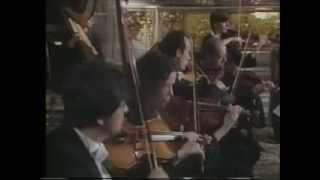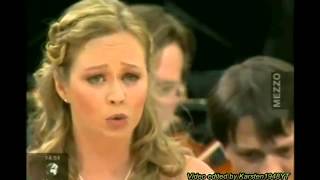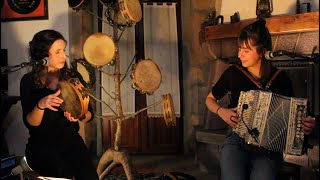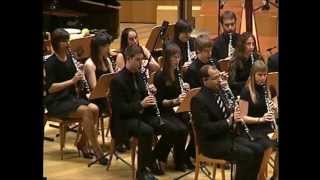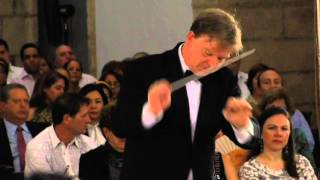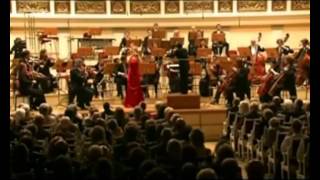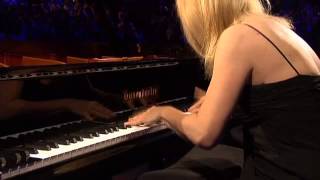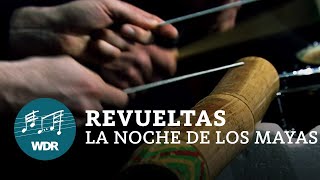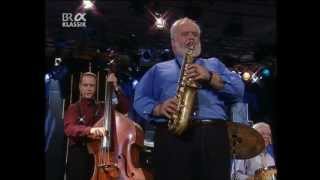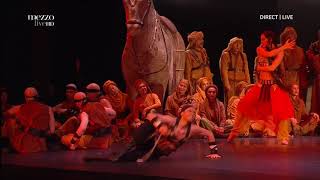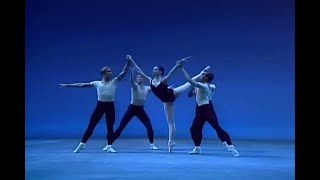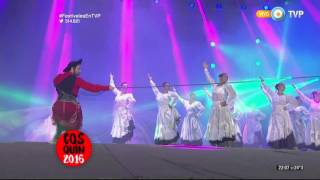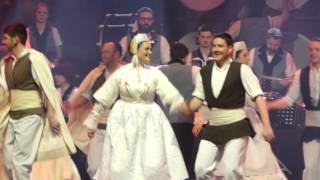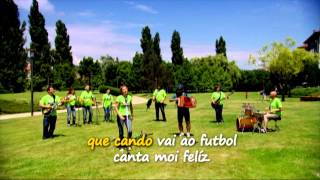Recommended music videos for initiation to classical music
Gabriel Fauré (1845-1924) was a French composer, pedagogue, organist and pianist. When he was just a child he was sent to the Niedermeyer music school in Paris , where he trained to be a church organist and choir director. Among his mentors was Camille Saint-Saëns , who became his lifelong friend. After graduating in 1865, Fauré earned a modest living as an organist and teacher, which left him little time to compose. When he achieved success and held the important positions of organist of the Madeleine church and director of the Paris Conservatory , he hardly had time to compose, which he recovered by retiring in the countryside during the summer holidays.
In his later years, Fauré was recognized in France as the most important French composer of his time; His harmonic and melodic innovations notably influenced the teaching of musical harmony for generations to come. His legacy has been described as the link between the end of Romanticism with the Modernism of the second quarter of the 20th century .
Catalog of Fauré's works . His works are classified by their Opus number ( from the Latin opus 'work'; op. abbreviation) which is a term used in music to catalog the works of most composers since the 17th century .
Sicilian (also known as sicilienne in French) is a musical form that became popular throughout Europe between the late 17th century and the 18th century . It is a slow dance that takes place in a time signature of 6/8 or 12/8 and is characterized by the presence of a trochaic rhythm , as well as by its simple melodies and clear harmonies and is usually written in a minor mode. It is a dance similar to the jig in terms of rhythm but much slower and with a melancholic character.
Edvard Grieg (1843-1907) was a Norwegian composer and pianist, considered one of the main representatives of musical romanticism. His mother, Gesine , was his first piano teacher; Later, she met the legendary Norwegian violinist Ole Bull , a family friend and her mother's brother-in-law. Grieg adapted many themes and songs from his country's folklore, thus contributing to creating a Norwegian national identity, just as Jean Sibelius did in Finland or Antonín Dvořák in Bohemia . His most important works are: the Piano Concerto in A minor , the intimate Lyrical Pieces (for piano), the Holberg Suite (for string orchestra) and, especially, Peer Gynt, incidental music that he wrote at the request of the writer Henrik Ibsen for his homonymous drama.
Catalog of Grieg's works . His works, like those of Fauré to which we have referred above, are classified by their Opus number.
Peer Gynt , op 23, is a musical composition for scenery, or incidental music, for reciters, vocal soloists, choir and orchestra by Grieg ; Although the two suites that the author himself wrote have become more famous among the general public, Suite No. 1 Op. 46 and no. 2 op. 55, for the play Peer Gynt by Norwegian playwright Henrik Ibsen .
From this incidental work, today we witness the famous Solveig Song performed by the Norwegian soprano Marita Solberg (1976), a singer who has worked with Marc Minkowski, Zubin Mehta, Michel Plasson and other great orchestra conductors. From 2006 to 2008 she was the lead singer of the Staatsoper, Stuttgart . He also performed at the Gran Teatre del Liceu in Barcelona, Teatro Real in Madrid, Komische Oper in Berlin and at the Norwegian National Opera .
Elizagoien Ahizpak (Itsaso and Irune Elizagoien, Etxalar, 1995 and 1993). With our cousin as a reference, since childhood we have had a fondness and taste for trikitixa . Our parents trusted the desire we had to learn to play this instrument, and therefore, from the moment we bought the first trikitixa , at 5 and 7 years old respectively, we entered this world. In 2002 we started with competitions (called txapelketas). We started in Etxalar , continuing through different towns in Gipuzkoa and arriving in Bizkaia , getting 27 txapelas each of us, and ending this stage of our lives with the Zeanuri txapelketa in 2015. Today the Elizagoien sisters play as duo at all kinds of popular events. (Extracted from Elizagoien Ahizpak 's website )
The Trikitixa is a diatonic button accordion, of Italian origin, that has been used since the 19th century in the Basque Country , especially in popular pilgrimages (in 1889 we have the first written mention of a pilgrimage with this instrument in Urkiola ); The most open theories say that this musical instrument came from the Alps , from the border between France and Italy . In the Basque Country , it is most often played together with a tambourine; that is, together with a tambourine. Therefore, more than the instrument itself, it is the type of music that this couple creates that is called by that name.
Bert Appermont (Bilzen, 1973) is a Belgian music educator, conductor, composer and arranger. He studied counterpoint, fugue, orchestra and conducting at the Lemmens Institute in Leuven . In 1998 he completed his studies there with a double master's degree in music education and HaFaBra conducting (HArmonie, FAnfare and BRAss band music). He continued his studies at Bournemouth Media School in England . There he obtained a Master's Degree in Musical Design for Film and Television , which gave him extensive knowledge of composition techniques for musicals, film and television. As a composer, in addition to two musicals, he has composed about one hundred works for choir, chamber music ensemble, wind orchestra and symphony orchestra.
Sabic Symphonic March . This vigorous symphonic march was commissioned by the company Sabic Europe for the opening of its new Dutch headquarters in Sittard. Innovation, an open mind and professional skill are the three main building blocks of this company and also serve as the basis of this composition. full of unexpected harmonic turns and original chord sequences, partly based on the name Sabic . A stirring acceleration brings this symphonic march to a spectacular conclusion. ( Stretta Music)
Today's performance is performed by the Symphonic Band of the Aragonese Youth Institute conducted by the composer himself, maestro Bert Appermont .
Recommended classical music videos
William Boyce (1711-1779), English composer, was a choirboy at St Paul's Cathedral , before studying music with Maurice Greene after his voice changed. His first professional performance came in 1734, when he took a job as organist at Oxford Chapel . He held many similar positions before being appointed Master of the King's Music in 1755, becoming organist at the Chapel Royal in 1758. Boyce is known for his set of eight symphonies, his anthems and his odes. He also wrote the masque Peleus and Thetis and songs for Secular Masque (by John Dryden ), incidental music for the plays of William Shakespeare and much chamber music.
Boyce 's Symphony No. 5 in D major comes from the Cecilian Ode See famed Apollo and the nine , composed in 1739. The symphony takes the form of the French Overture . The First Movement (0´40´´) ALLEGRO MA NON TROPPO, uses trumpets and timpani in the solemn manner of Händel , continuing (2´10´´) ALLEGRO ASSAI in a fugal form. The Second Movement (4´48´´), TEMPO DI GAVOTTA, uses this characteristic dance derived from the dance suites. The Last Movement, (6´22´´) TEMPO DI MINUETTO, is another of the dances used in the suites. (Extracted from the History of the Symphony).
Today we offer it in the version of the Colonial Camerata of Santo Domingo conducted by the American master John Thomas Dodson .
The Austrian composer Joseph Haydn (1732-1809), whose brother Michael Haydn was also a notable composer, was one of the main pillars on which classicism (1750-1820) was based. At the age of six he began his musical studies of harpsichord and violin. At the age of eight he was admitted as a choralist at St. Stephen's Cathedral in Vienna where he continued his studies in singing, piano and violin. After changing his voice, he had to survive by working multiple jobs, while studying composition analyzing the works of Carl Philipp Emanuel Bach . He maintained a close friendship with Mozart and was Beethoven 's teacher. He laid the main foundations of the sonata form and the formal structure of the string quartet and the symphony. He died at the age of 77 in Vienna .
The catalog of Haydn's works . The works of Joseph Haydn are today classified according to the system created by Anthony van Hoboken and revised and completed by Robbins Landon and his wife Christa , which has been universally adopted, although it is now known that it does not accurately reflect the chronology and composition of the works. works, criteria used by Hoboken in the catalog. Each work is identified with a Roman numeral that corresponds to the category, which in most cases corresponds to a genre. Some categories have subdivisions, which are indicated with a lowercase letter and then an Arabic number appears that corresponds to the order of the specific work within the category. These figures are preceded by the word Hoboken (in memory of the catalog's author) and sometimes by Hob .
The Concerto for trumpet and orchestra in E flat major, Hob. VIIe/1, is Haydn 's only concerto for this instrument. It was composed by Haydn in 1796, when he was 64 years old, at the request of Anton Weidinger , who spent about 4 years testing his new instrument with minor works and perfecting his own technique. He premiered it on March 22, 1800 in Vienna . It is the first concerto for five-key trumpet, an instrument created to overcome the limitations of traditional bronze instruments; instrument that would be surpassed by the current three-piston trumpet created in 1813. The concerto is articulated in three movements: I (0´29´´) ALLEGRO written in sonata form.- . II (7´10´´) ANDANTE also written in sonata form.- . III (11´00´´) FINALE ALLEGRO written in rondo form .
Today's version is offered to us by the brilliant English trumpeter Alison Balsom , who, despite her youth, was named Artist of the Year by the Gramophone Awards in 2013; in 2009 she performed as a soloist at the London Proms evenings and has been awarded honorary doctorates from the University of Leicester and Anglia Ruskin University ; He is an honorary member of the Guildhall School of Music and Drama .
Ludwig van Beethoven (1770-1827) together with Bach and Mozart is part of the trio of giants of Western music. Born in Bonn , his father of Flemish origin, tried to make him a second Mozart , although it was a notable failure. Despite this, from the age of nine the organist Christian Gottlob Neefe captivated him with the study of Bach . In 1787 he moved to Vienna with the intention of taking Mozart classes, but the death of his mother returned him to Bonn a few days later. And so after five years, he returned to Vienna where he contacted Haydn and Salieri , becoming known as a composer and pianist with notable public recognition. However, his profession as a pianist could not be carried out due to deafness that attacked him the following year, leaving him completely incapable of this faculty.
The catalog of Beethoven's works . There are 138 musical works composed by Beethoven , arranged by numbers known as opus (“work” in Latin) or its abbreviation op. , assigned by the composer's publishers while he was alive. On the sidelines, there are another 205 works that do not have an opus number and that were published after the composer's death. These works were assigned WoO numbers (Werke ohne Opuszahl, "works without opus number"). This catalog was first produced by Georg Kinsky and Hans Halm (Das Werk Beethovens) in 1955.
The Sonata was originally a composition written to be played or "sounded" by one or more musical instruments, as the cantata was to be "sung" by one or more voices. From classicism (1750-1810) its definition stabilizes, which is applied to a composition for one or two instruments and which generally consists of three movements (fast-slow-fast) and sometimes four, with or without a short introduction. . It should not be confused with the sonata form , which is a compositional model that consists of three sections without interruption: a) exposition, b) development, c) reexposition. Sonata form is typically applied to the first movements of sonatas, quartets, symphonies, and concertos .
Beethoven 's Sonata No. 14 op 27 No. 2, popularly known as “Moonlight,” is one of his most famous works. It was composed in 1801 and consists of the following three movements: I (0´02´´) ADAGIO SOSTENUTO. It is written in similarity to the ternary lied form and many see it as having similar characteristics to the sonata form . A melody that Hector Berlioz called "lament" is played almost entirely in the right hand.-. II (5´21´´) ALLEGRETTO. It is a minuet of a fairly peaceful nature and without any surprises, an element to contrast with the following movement. III (7´53´´) PRESTO AGITATO. It involves an experiment by Beethoven and is written in sonata form . The movement consists of rapid arpeggios, scales, and a skillful game of questions and answers between the two hands. Its difficulty is very high and contrasts with that of the two previous movements.
Today it is offered to us by Valentina Lisitsa (1973), a Ukrainian pianist who has lived in the USA since 1991, and is currently the most viewed classical concert pianist on the internet.
Silvestre Revueltas (18991-1940) was a modernist Mexican composer of symphonic music of the first half of the 20th century , violinist and orchestra director. Appointed by Carlos Chávez as assistant director of the Mexican Symphony Orchestra , it was difficult for him to dedicate himself to composition due to his lack of self-esteem and because due to his leftist ideas he was long cornered by Mexican society. He traveled to Spain in the middle of the Civil War as personal support for republicanism and upon his return he wrote Sensemayá . He is currently considered one of the most influential composers in Mexico , due to the scope and originality of his chamber music and certain works that have become a very important part of the orchestral repertoire.
The Night of the Mayans is a musical composition by Silvestre Revueltas written as the soundtrack for the film of the same name that had two subsequent arrangements: one by Paul Hindemith and the other, the one we offer today, by José Ives Limantour , a work made 20 years after the death of the composer. Limantour structured the music of the film in the form of a symphony, including pre-Hispanic percussion instruments and structuring it in the following four movements I (0´00´´) NOCHE DE LOS MAYAS, Molto sostenuto .-. II (6´33´´) NIGHT OF JARANAS, Scherzo .-. III (12'00'') YUCATAN NIGHT, Andante espressivo .-. IV (17'53'') NIGHT OF ENCHANTMENT, Theme and variations .
Today it is offered to us by the WDR Symphony Orchestra under the baton of the Russian maestro Semyon Bychkov .
Recommended music videos for all tastes
The Dave Brubeck Quartet was a jazz quartet , founded in 1951 by Dave Brubeck and originally consisting of Paul Desmond on sax and Brubeck on piano. In 1958, the " Classic Quartet" would finally be formed with Brubeck , Desmond , Joe Morello on drums and Eugene Wright on bass. In 1959, the Dave Brubeck Quartet released Time Out , an album that generated enthusiasm at their production company. The album included original compositions and almost none of the songs had a simple meter. With these irregular and unusual musical rhythms it quickly achieved high sales and platinum status in its country. The quartet continued this success with a large number. of new albums within the same musical line.
Lucero Hogaza León (Mexico City, August 29, 1969) known artistically as Lucero , is a Mexican singer-songwriter, actress, television presenter and businesswoman; She is also known as America's Bride . Since she was a child, she began starring in children's programs on Mexican television. He then released a series of successful albums. Some of their songs reached the top of most Latin charts, including the Billboard charts in the United States . She received her first leading role in the film Coquette and filmed a total of seven films. Lucero has starred in nine Mexican soap operas, has hosted the Latin Grammy Awards eight times, and has been the face of the fundraising program Teletón México .
Manuel Carrasco (1981) is an Andalusian singer born in Isla Cristina ( Huelva ) and emerged from the second edition of Operación Triunfo (2002). Since he was a child, he participated in musical festivals and later, in musical events as a troupe director. In Operación Triunfo , upon achieving second place, he chose to represent Spain in Eurovision with the song Viviré, muerteé although it would later be discarded. In 2003 he obtained a double platinum record and the following year he won the II World Song Festival in Puerto Rico . In 2008 he once again won a double platinum album, becoming known throughout Latin America . His career continued with success and his album Bailar el viento obtained five platinum records . Today we offer an album with some of his most popular songs.
Adele (London, 1988) is a British singer-songwriter and multi-instrumentalist. She is one of the best-selling musical artists in the world, with more than 120 million sales between albums and singles. The release of each of their albums set important sales records around the world; Due to its sales, it has been certified seventeen times platinum in the United Kingdom and in the United States it was certified diamond and has several mentions in the Guinness World Records; She was also decorated as a Member of the Order of the British Empire by Prince Charles . Throughout her career she has been awarded a total of fifteen Grammy Awards, twelve Brit Awards, an Oscar and a Golden Globe , among others. In 2020, their album 21 has been included in the list of the 500 greatest albums of all time according to Rolling Stone .
Recommended peculiar videos
Prince Igor (Князь Игорь / Knyaz' Igor') is an opera by Alexander Borodin , inspired by the campaign of Prince Igor of Kyiv against the Polovtsy or Cumans of Khan Kontckak , according to a 12th-century epic poem, " The Tale of the Campaign of Igor ." Unfinished when Borodin died in 1887, it was completed by Nikolai Rimsky-Korsakov and Alexander Glazunov and premiered on November 4, 1890 at the Mariinsky Theater in Saint Petersburg . The famous Polovtsian dances, which we offer today, take place at the end of Act 2, in the Kontchak camp where Igor is a prisoner. (Text extracted from the bottom of the video)
Four Temperaments ( The Four Temperaments or Theme and Four Variations ) is an orchestral work and ballet by Paul Hindemith originally conceived as a ballet for Léonide Massine , although it was eventually completed as a commission for George Balanchine , who choreographed it as a neoclassical ballet. The music was premiered in Switzerland by the Stadtorchester Winterthur under the direction of Hermann Scherchen on March 10, 1943. However, Balanchine created the choreography a few years later. The ballet The Four Temperaments was the first work Balanchine performed for the Ballet Society , the precursor of the New York City Ballet , and premiered on November 20, 1946 at the Central High School of Needle Trades, New York , during the first performance of the Ballet Society .
Structure : 00:00 Three themes.-. 6:25 Variation 1.-. 12:18 Variation 2.-. 17:45 Variation 3 .-. 23:55 Variation 4
Argentine National Folkloric Ballet . It is an Argentine folk dance company, based in Buenos Aires , created in 1990 and made up of 40 dancers at whose service there is a technical team of specialists in costumes, lighting and sound. Its objective, the creation of choreographies and sets of legends and customs from the different Argentine regions.
The Cosquín National Folklore Festival is the most important folklore festival in Argentina ; It is celebrated in the city of Cosquín , province of Córdoba , in the last week of January for nine nights in a row, along with the novena of the Virgin of the Rosary , patron saint of the city.
Today we offer the gala held in 2016.
Breton dance is a traditional dance form originating in Brittany , the Celtic region of France . In 19th century agricultural society, the most common occasion for dancing was a wedding. Other opportunities to dance were: hitting the dirt floor of a new house or repairing a damaged clay floor by preparing a threshing floor. Celebrations after agricultural work (such as a harvest festival) were secular celebrations accompanying a religious holiday. More recently, throughout the second half of the 20th century , there has been a revival of traditional Breton dance , to such an extent that it can now be considered at the forefront of contemporary Breton cultural expression, along with the music that accompanies it. .
The Maraîchine is a traditional French dance, danced in a line or in a circle, widespread in the Marais Breton-Vendéen and the Marais Poitevin .
Recommended music videos for children
Various Wikipedia articles have been used to write these texts.
The texts of Videomusicalis are written in Basque, Spanish and English.





